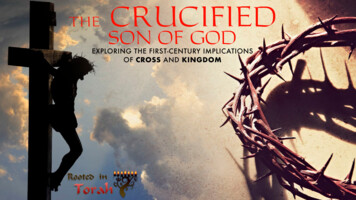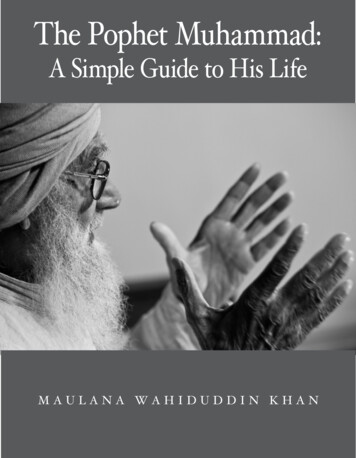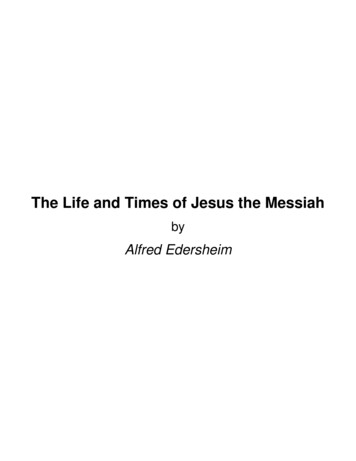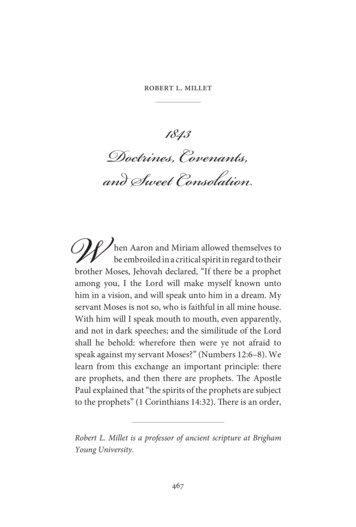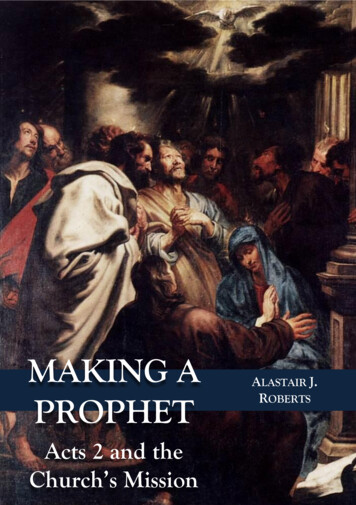
Transcription
Chapter 11JESUS THE MESSIAH:PROPHET, PRIEST AND KINGDavid Rolph Seely and Jo Ann H. Seelyur Heavenly Father's plan togive immortality and eternal life to His children required aSavior (see Moses 1:39). In the premortal council in heaven,the Beloved Son volunteered to be this Savior with the words,"Father, thy will be done" (Moses 4:2). The Beloved Son iscalled Jehovah in the Old Testament. He is the one whocreated the heavens and the earth, who gave the law onMount Sinai, and who communicated His will through theprophets.All of the prophets from the beginning prophesied thecoming of Jehovah in the flesh to perform the Atonement andto be the Savior of the world (see Mosiah 13:33). Theydescribed the mortal Jehovah with many titles, includingSavior (see Moses 1:6), Immanuel (see Isaiah 7:14), Lamb ofGod (see Isaiah 53:7), Redeemer (see Isaiah 41:14), and Son ofMan (see Daniel 7:13). The prophets of the Book of MormonDavid Rolph Seely is a professor of ancient scripture, and Jo Ann H.Seely is a part-time instructor of ancient sciipture at Brigham YoungUniversity.248
DAVID ROLPH SEELY AND /O ANN H. SEELY249knew that His earthly name would be Jesus (see 2 Nephi25:19), a name that means "Jehovah is salvation." One of themost important of these titles is Messiah, or Anointed One,usually found in its Greek form, Christ.The word Messiah simply means "anointed one" andderives from the Hebrew verb mashach, meaning "to anoint."1The word messiah translated into Greek is christos, from theGreek verb chrio, "to anoint." Thus, the name Jesus Christ is acombination of Jehovah's earthly name, Jesus, and title, Christ,and every time we see the word Christ we can read and understand Messiah. The title Messiah occurs in the book of Moses(see Moses 7:53) and throughout the Old and New Testaments,where it usually occurs in English translations of the Bible asChrist. This title is also of great significance in the Book ofMormon, where the title page records that one of the mostimportant purposes of this ancient record is "the convincingof the Jew and Gentile that Jesus is the Christ." The meaningof the title Messiah or Christ is a key to understanding the roleof Jehovah in the plan of salvation.In ancient Israel, those who held any of three religiousoffices were anointed: prophets, priests, and kings. Jesus Christfulfilled all three of these offices. An exploration of the Messiahas prophet, priest, and king will greatly increase our understanding and appreciation of the Savior, Jesus the Messiah.ANOINTING AND ANOINTED ONEThe practice of anointing was widespread in ancient Israeland throughout the ancient world. In particular, those who1. The English word Messiah is an anglicized form of the Latin Messias, borrowed from the Greek Messias, adapted from Aramaic meshicha,'a translation ofthe Hebrew ha-mashiach, "the Anointed." A convenient discussion of this wordcan be found in E. Jenni, "Messiah," G. A. Buttrick et al., The InterpretersDictionary of the Bible (Nashville: Abingdon Press, 1962), 3:360-61.
250JESUS THE MESSIAH: PROPHET, PRIEST, AND KINGwere called to any one of three sacred offices were anointedin ancient Israel: prophets (see 1 Kings 19:16), priests (seeExodus 29:7-9; Leviticus 8:10-12), and kings (see 1 Samuel10:l).2 In the Old Testament, anointing was done with olive oil,which was sometimes mixed with perfumes and spices,3 Oliveoil, associated with prosperity, wealth, cleansing, healing, andpurity, symbolized the Spirit.4 The ritual of anointing was performed by pouring oil on the head of the individual to beanointed, was often done in conjunction with washing andclothing in new clothes, and was accompanied by blood sacrifice.5 A review of the biblical texts reveals several symbolicaspects of anointing that help us understand the meaning ofthe term Messiah.1. Anointing symbolized a change in status or setting apart toa divinely inspired calling. This is demonstrated by the consecration of kings, priests, and prophets, who were called to specific functions: kings to rule, priests to represent the peoplebefore the Lord in holy places, and prophets to deliver theword of the Lord.2. Anointing is a symbol ofpurification. In the case of priests(see Leviticus 8:6-9), brides as they entered into marriage (seeEzekiel 16:9-13), and lepers (see Leviticus 14:8-20), anointingwas accompanied with washing and dressing in new clothes.2. A convenient review of anointing can be found in Donald W. Parry, "RitualAnointing with Olive Oil in Ancient Israelite Religion," in The Allegory of theOlive Tree, ed. Stephen D. Ricks and John W. Welch (Salt Lake City: Deseret Bookand Foundation for Ancient Research and Mormon Studies, 1994), 262-89.3. The recipe for the sacred anointing oil is found in Exodus 30:22-25.4. See John A. Tvedtnes, "Olive Oil: Symbol of the Holy Ghost," in Ricks andWelch, eds., The Allegory of the Olive Tree, 427-59.5. In Exodus 29:4-9 and Leviticus 8:6-9, Aaron and the priests were washedwith water and clothed in the clothing of the priesthood before their ordination.This anointing was followed by sacrifice. In Ezekiel 16:9-13, a bride is washedwith water, anointed with oil, and then arrayed in the clothing of the bride.
DAVID ROLPH SEELY AND JO ANN H. SEELY2513. Anointing is a symbol of consecration—making someone orsomething holy. Priests were anointed so that they could beconsecrated, able to officiate in sacred places—in particular,the tabernacle and the temple (see Exodus 30:30). Sacredobjects and furnishings of the tabernacle and temple were alsoanointed with oil to consecrate them (see Exodus 30:26-29).4. Anointing with oil was a symbol of gladness among thecommon people. This anointing is called the "oil of gladness"(Psalm 45:7) and was not to be done in times of mourning (see2 Samuel 14:2).5. Anointing was done in connection with specific blessingsgiven to the individual. Some scholars have identified this withthe symbolism of the ability of olive oil to penetrate the skin.Some have suggested that one of the aspects of anointing is tointernalize specific blessings or curses pronounced at the timeof the anointing.6A review of the scriptural records of the anointing of specific individuals can increase our understanding of how theOld Testament peoples understood the ritual of anointing andhence the meaning of the term Messiah.The anointing of prophets is attested in the story of Elijahand Elisha. Elijah was commanded to anoint Elisha as his successor (see 1 Kings 19:16). While no account of the anointingis found, this anointing is clearly to be understood as a symbol of the transfer of the prophetic call from Elijah to hissuccessor. In the story, this transfer is further symbolizedwhen Elisha took up the mantle of the translated Elijah (see6. For example, a passage from an Assyrian treaty reads: "As oil penetratesyour flesh, so may they {the gods] make this curse enter into your flesh." D. J.Wiseman, "The Vassal-Treaties of Esarhaddon" Iraq 20 (1958), 78, lines 622-24.This same symbolism is perhaps reflected in Psalm 109:18: "As he clothedhimself with cursing like as with his garment, so let it come into his bowels likewater, and like oil into his bones."
252IESUS THE MESSIAH: PROPHET, PRIEST, AND KING2 Kings 13). The mantle was a visible symbol of the significance of the anointing—that Elisha would resume the power,authority, and responsibilities of the mission of Elijah andwould deliver the same message and perform many of thesame miracles—miracles that would prefigure the coming of afuture prophet. Thus, Elijah and Elisha both parted the watersof the Jordan (see 2 Kings 2:8; 14), both multiplied food (see1 Kings 17:14-16; 2 Kings 4:42-44), and both raised childrenfrom the dead (see 1 Kings 17:23; 2 Kings 4:34-37). Jesus, theAnointed One, would do the same miracles as He calmed thestorm, fed the five thousand, and raised the dead.The anointing of priests conveys the sense of makingholy—of consecration or sanctihcation. Anointing in the OldTestament is often connected with the term "to sanctify," aswith the instruction to "anoint" and "sanctify" (Exodus 29:36).The ordinance of anointing priests is recounted in Exodus29:4-9 and Leviticus 8:6-9. In this ceremony, the priests arewashed with water and anointed with blood and oil. In fact,throughout the Old Testament priests are anointed to set themapart, to separate them from the realm of the profane, and toenable them to function in the realm of the sacred at the tabernacle and temple. Their calling is often described with theverb meaning "to consecrate"—to "make holy."7 Their functionwas to represent the people before the Lord in the tabernacleand the temple and in turn to bless the people on behalf of theLord through their priesthood.There are several accounts in the Old Testament of theanointing of kings.8 This anointing apparently conferred onthe king the Spirit of the Lord (ruach YHWH). The accounts of7. Parry, "Ritual Anointing," 271-75.8. Saul (see 1 Samuel 10:1); David (see 1 Samuel 16:1); Solomon (see 1 Kings1:39); Joash (see 2 Kings 11:12); Jehoahaz (see 2 Kings 23:30); Hazael of Aram,Jehu son of Nimshi of Israel (see 1 Kings 19:15-16).
DAVID ROLPH SEELY AND }0 ANN H. SEELY253the anointing of Saul and David record that after the anointing the Spirit of the Lord fell upon them. Hence, in ancientIsrael olive oil and anointing often symbolized the Spirit.9 Anexample of this can be found in Isaiah 61:1, the passage ofIsaiah that the Savior read in the synagogue in Nazareth, asrecorded in Luke 4:18-19; there the Anointed One describedin Isaiah 61:1 states that "the Spirit of the Lord God is uponme." The anointing with oil also symbolized the giving of helpand support from the Lord (see 1 Samuel 16:13-14). Theanointing of kings promised them specific blessings ofstrength (see Psalm 89:21-25), wisdom (see Isaiah 11:1-4) andjustice (see Isaiah 11:3).1ESUS THE MESSIAHJesus came as the Messiah, or Anointed One, in all threeoffices: prophet, priest, and king. When was Jesus anointed toHis calling? In fact, there is evidence of three anointings ofJesus: once in the premortal existence, and twice during Hismortal ministry.The Prophet Joseph Smith supports the belief that Jesuswas first anointed in the premortal existence: "He, the Lordbeing a priest forever, after the order of Melchizedek, and theanointed Son of God, from before the foundation of the world."10Elder Bruce R. McConkie, echoing the words of Joseph Smith,taught the same doctrine: "And Christ our Lord, Firstborn ofthe Father, mightiest of all the spirit host, a Man like unto hisFather, was also chosen and foreordained and anointed to9. Anointing with oil symbolizes the giving of the Spirit (see 1 John 2:20, 27).See D&C 45:57, where the oil also represents the Holy Spirit in the parable ofthe ten virgins.10. Joseph Smith, Teachings of the Prophet Joseph Smith, sel. Joseph FieldingSmith (Salt Lake City: Deseret Book, 1976), 265; emphasis added.
254JESUS THE MESSIAH: PROPHET, PRIEST, AND KINGcome into mortality and do the very work that he thenaccomplished."11The second anointing occurred in conjunction with thebaptism of Jesus. In the New Testament, Peter taught that thebestowal of the Holy Ghost to Jesus after His baptism represented a mortal anointing of the Messiah. In a sermonrecorded in the book of Acts, Peter stated: "That word, I say,ye know, which was published throughout all Judaea, . . afterthe baptism which John preached; how God anointed Jesus ofNazareth with the Holy Ghost and with power: who wentabout doing good, and healing all that were oppressed of thedevil; for God was with him" (Acts 10:37-38).The third account of anointing is found in John 12:3-8,when Mary anointed the Savior in Bethany just prior to Histriumphal entry into Jerusalem. Elder McConkie taught:As Samuel poured oil on the head of Saul andanointed him to be captain over the Lord's inheritance,and all Israel then marched at their king's word;As he also poured oil on David and anointed him inthe midst of his brethren, so that the Spirit of the Lordcame upon him from that day forward;And as Zadok took an horn of oil and anointedSolomon, and all the people said, "God save kingSolomon"—So Mary of Bethany, in the home of Simon the leper,as guided by the Spirit, poured costly spikenard from heralabaster box upon the head of Jesus, and also anointedhis feet, so that, the next day, the ten thousands of Israelmight acclaim him King and shout Hosanna to his name.11. Bruce R. McConkie, The Mortal Messiah, 4 vols. (Salt Lake City: DeseretBook, 1979-81), 1:26.
DAVID ROLPH SEELY AND fO ANN H. SEELY255We see Jesus thus anointed and acclaimed, heading a triumphal procession into the Holy City.12Jesus was prefigured in the offices of prophet, priest, andking by three pivotal figures in the Old Testament. The officeof prophet is represented by Moses, through whom the Lordprophesied, "I will raise them up a Prophet from among theirbrethren, like unto thee [Moses]" (Deuteronomy 18:18). Theoffice of priest is represented by Melchizedek. The Lordprophesied to David that his messianic descendant would be"a priest for ever after the order of Melchizedek" (Psalm 110:4).And the office of king is represented by David—hence, Jesus'title as the Son of David. The lives and ministries of thesethree individuals—Moses, Melchizedek, and David—providedtypes to help those in Old Testament times who did not knowthe details of the future life of the Messiah to understand themission of the Messiah even before He came in the flesh. Thefollowing will explore the Old Testament prophecies of thecoming of the Messiah, the Anointed One, in terms ofprophet, priest, and king and discuss how the Savior fulfilledeach of these offices in His mortal ministry.JESUS AS PROPHETThe central mission of the prophets in the Old Testamentwas to be the mouthpiece of the Lord to call people to repentof their sins and to come unto the Lord. In short, the role ofprophets is to bring people to Christ. One function of allprophets was to teach the people about the coming of theMessiah. Abinadi taught that "all the prophets who haveprophesied ever since the world began" testified of Christ andHis future coming (Mosiah 13:33).One of the greatest prophets in the Old Testament was12. McConkie, Mortal Messiah, 3:327.
256JESUS THE MESSIAH: PROPHET, PRIEST, AND KINGMoses. He taught of the coming of Christ in two w7ays—by hisactions and through his words. First, his life stands in the OldTestament as a type of Christ in many ways. He deliveredIsrael from Egypt, he taught them of the Lord's redemption onthe night of Passover, he gave them the law on Mount Sinai,he was a worker of great signs and miracles, he led the children of Israel in battle against their enemies, and he mediatedbetween God and the people. Moses stands as a type of deliverer, redeemer, lawgiver, miracle worker, and mediator.Moses also fulfilled the prophetic role of mouthpiece forthe Lord as he called the children of Israel to repentance andprepared them to enter the promised land. In one of his finalsermons to his people, Moses spoke of a revelation from theLord about the coming of the Messiah: "I will raise them up aProphet from among their brethren, like unto thee, and willput my words in his mouth; and he shall speak unto them allthat I shall command him" (Deuteronomy 18:18). Nephitaught that "this prophet of whom Moses spake was the HolyOne of Israel" (1 Nephi 22:21). The children of Israel understood that they would recognize in the Messiah one like untoMoses, one who would be a prophet, one who would deliverthem, teach them, manifest great power, and mediate withGod for them.Thus, the Savior would come to His people in the anointedrole of prophet. The Gospels give us many examples of Jesusin His role as a prophet.1. Jesus was likened to Mosesu Many of the stories of the lifeof the Savior are deliberately shaped to show that Jesus cameas the prophet like unto Moses. For example, both were miraculously saved from death: Moses as an infant in the basket in13. Dale C. Allison Jr., The New Moses: A Matthean Typology (Minneapolis:Fortress Press, 1993).
DAVID ROLPH SEELY AND 10 ANN H. SEELY25 7the Nile (see Exodus 1, 2) and Jesus as an infant taken toEgypt (see Matthew 2). In Matthew 4, Jesus is tempted in thedesert for forty days and nights in preparation for His ministry. Although the parallel record of Satan's encounter withMoses is missing in the Bible, it is preserved in the Pearl ofGreat Price (see Moses 1). Moses, in his ministry, confrontedPharaoh (see Exodus 5-12), while Jesus, in His ministry, confronted the Pharisees, Sadducees, scribes, Herod Antipas, andPilate. Moses was the mouthpiece through which the Lorddelivered the law at Mount Sinai (see 19-24), while Jesusdelivered His law in the Sermon on the Mount (see Matthew5-7). Moses performed many miracles—the plagues, the parting of the Red Sea, the water from the rock, bread and quail inthe wilderness. Jesus healed the sick, fed the five thousand,walked on water, and raised the dead. Moses entered into thepresence of God and was transfigured before Him (see Moses1:11), and "the skin of his face shone" (Exodus 34:29) when hecame off the mount from talking with the Lord. Likewise, theSavior was transfigured on the Mount of Transfiguration, and"his face did shine as the sun" (Matthew 17:2). Moses officiatedat the first Passover meal in Egypt (see Exodus 12), while theSavior presided at the last Passover celebrated at the LastSupper (see Matthew 26).When the Savior appeared to the Nephites following Hisresurrection, He himself announced: "I am he of whom Mosesspake, saying: A prophet shall the Lord your God raise up untoyou of your brethren, like unto me; him shall ye hear in allthings whatsoever he shall say unto you" (3 Nephi 20:23).2. Jesus was recognized as a great prophet risen up amongIsrael Elijah was another great prophet of the Old Testamentand one to whom the Israelites looked to return. He didindeed return with Moses at the Transfiguration and yet againto the Kirtland Temple to deliver priesthood keys. During his
258JESUS THE MESSIAH: PROPHET, PRIEST, AND KINGministry, Elijah confronted the priests of Baal, sealed theheavens, and raised the son of the widow of Zarephath.Similarly, when Jesus entered a small village called Nain, Hewas met by a widow whose only son had died. After Jesusraised her son from the dead, the people became afraid "andthey glorified God, saying, That a great prophet is risen upamong us; and, That God hath visited his people" (Luke 7:16).The news spread all about the region, for the people recognized one who manifested the power of God as did Elijah andthe great Israelite prophets. When Herod Antipas heard of Hisfame, he feared John the Baptist had risen from the dead, butothers said, "That it is Elias [the New Testament form ofElijah]. And others said, That it is a prophet, or as one of theprophets" (Mark 6:15).3. Jesus acknowledged Himself as a prophet. After readingthe messianic passages from the book of Isaiah in the synagogue at Nazareth, Jesus declared, "This day is this scripturefulfilled in your ears." When the crowd began to wonder, "Isnot this Joseph's son?" Jesus replied, "Verily I say unto you,No prophet is accepted in his own country" (Luke 4:21, 22, 24).Later, when warned to "depart hence: for Herod [Antipas] willkill thee," Jesus replied that He would continue on, "for it cannot be that a prophet perish out of Jerusalem" (Luke 13:31,33).4. Jesus followed in the tradition of the prophets. Mosespassed along his prophetic keys to Joshua by the laying on ofhands. Elijah had anointed the prophet Elisha to follow himand also passed his mantle to Elisha. Jesus followed theprophet John the Baptist. John's message was simple: "Repentye: for the kingdom of heaven is at hand" (Matthew 3:2).Jesus, at the outset of His ministry, began with the same message, and later His Apostles were given the same message.Just before announcing that He would give unto Peter the
DAVID ROLPH SEELY AND }Q ANN H. SEELY259keys of the kingdom, the Lord provided Peter with the opportunity to declare his faith. "When Jesus came into the coastsof Caesarea Philippi, he asked his disciples, saying, Whom domen say that I the Son of man am? And they said, Some saythat thou art John the Baptist: some, Elias; and others,Jeremias, or one of the prophets. He saith unto them, Butwhom say ye that I am? And Simon Peter answered and said,Thou art the Christ [Messiah], the Son of the living God"(Matthew 16:13-16).Jesus Christ was indeed a prophet but he was even morethan a prophet. He was, as Nephi said six hundred yearsbefore His birth, "a prophet. . . —even a Messiah, or, in otherwords, a Savior of the world" (1 Nephi 10:4).JESUS AS PRIESTIn the Old Testament, the Lord prophesied to David thatthe future Messiah would be a priest: "The Lord hath sworn,and will not repent, Thou art a priest for ever after the orderof Melchizedek" (Psalm 110:4).Just as the prophetic role of the Messiah was prefigured inthe Old Testament by Moses, so the priestly role of theMessiah was prefigured in the Old Testament by the greatMelchizedek, king of Salem, priest of the most high God (seeGenesis 14:18). The Joseph Smith Translation and the Book ofMormon restore many important truths about Melchizedek(JST, Genesis 14:25-40; Alma 13.14-19). Melchizedek was "anhigh priest after the order of the covenant which God madewith Enoch" (JST, Genesis 14:27). Through the power of thispriesthood, Melchizedek had the same power as Enochpower over the elements, power to defy the armies of nations,and the power to be translated and taken into heaven (seeJST, Genesis 14:30-32). Through this power, Melchizedekestablished peace in Salem and was called the "Prince ofpeace," and "King of peace" (JST, Genesis 14:33, 36)—titles that
260JESUS THE MESSIAH: PROPHET, PRIEST, AND KINGwould foreshadow the coming of Christ. According to theJoseph Smith Translation, the people of Melchizedek "wroughtrighteousness, and obtained heaven, and sought for the city ofEnoch" (JST, Genesis 14:34). Melchizedek became the nameused for the Holy Priesthood after the order of the Son of God(see D&C 107:1-2). It was Melchizedek who ordainedAbraham to the Melchizedek Priesthood (see D&C 84:14) andto whom Abraham paid his tithing (see Genesis 14:20). Andthe scriptures record that Melchizedek blessed Abraham (seeGenesis 14:19, JST, Genesis 14:40).The God Jehovah came to earth and officiated with theMelchizedek Priesthood. Jesus was not born of a Levitical lineage but came through Judah, the royal lineage. He fulfilled theprophecy, being the priest after the order of Melchizedek, sincethe lineage of Levi was not required for the higher priesthood(see Hebrews 7:11-12). While there is little information in theOld Testament about priests holding the Melchizedek Priesthood, there is much about the Aaronic Priesthood, and themission of Jesus Christ is largely explained in the NewTestament after the model of the Aaronic high priest.The anointing of the Aaronic priests is recorded inLeviticus 8. Aaron was washed with water (see Leviticus 8:6)and clothed with the clothing of the high priest: a coat, a robe,an ephod, the Urim and Thummim, and a head covering witha gold plate on his forehead that said "holiness to the Lord"(Exodus 28:26). Moses anointed Aaron with blood upon the tipof his right ear, upon the thumb of his right hand, and uponthe great toe of his right foot—probably symbolizing theanointing of the whole body. Finally, Moses anointed Aaronwith oil and sprinkled the oil and the blood on his garments(see Leviticus 8:30). Thus, the priests were washed, clothed,and anointed with blood and oil. In the scriptures, this entire
DAVID ROLPH SEELY AND JO ANN H. SEELY261process is called consecration, and it symbolized purification—by water and blood—with a setting apart by oil.In the Old Testament, the priests had many functions.Their duties can be summarized under three categories: (1) tobless the people (see Numbers 6:22-27); (2) to offer sacrificesand offerings for the people in order to bring about the forgiveness of their sins and transgressions (see Leviticus 1-6);and (3) to be a mediator between God and His people (seeLeviticus 16). It is possible to trace how Jesus fulfilled each ofthese three priestly functions in His ministry:1. The high priest and the priests would formally bless Israel.Twice each day after the regular sacrifices at the temple, thepriests would bless all of Israel with a blessing called thePriestly Benediction, found in Numbers 6:22-27:And the Lord spake unto Moses, saying,Speak unto Aaron and unto his sons, saying, On this wise yeshall bless the children of Israel, saying unto them,The Lord bless thee,and keep thee:The Lord make his face shine upon thee,and be gracious unto thee,The Lord lift up his countenance upon thee,and give thee peace.And they shall put my name upon the children of Israel;and I will bless them.Each part of this blessing was fulfilled by the Savior in Hismortal ministry.The Lord bless thee,and keep thee:The Sermon on the Mount began with a series of blessingscalled the Beatitudes: "Blessed are the poor in spirit" (Matthew5:3). Throughout His ministry, Jesus blessed the lame, thedeaf, and especially little children: "And he took their little
262IESUS THE MESSIAH: PROPHET, PRIEST, AND KINGchildren, one by one, and blessed them, and prayed unto theFather for them" (3 Nephi 17:21). At the Last Supper, the Lordpronounced the high priestly prayer upon His Apostles (seeJohn 17).The Lord make his face shine upon thee,and be gracious unto thee,These verses bring to mind the times when Jesus' faceshone upon the lame as He caused them to walk, the blind asHe caused them to see, the lepers as He healed them, the sinners as He forgave their sins, and the dead when He raisedthem. On the Mount of Transfiguration, Jesus "was transfigured before them [Peter, James, and John]: and his face didshine as the sun" (Matthew 17:2).The Lord lift up his countenance upon thee,and give thee peace.The Savior told His Apostles at the Last Supper: "Peace Ileave with you, my peace I give unto you: not as the worldgiveth" (John 14:27).And they shall put my name upon the children of Israel;and I will bless them.Throughout His ministry, Jesus taught, "Where two orthree are gathered together in my name, there am I in themidst of them" (Matthew 18:20). John explains this doctrineat the beginning of his Gospel: "But as many as received him,to them gave he power to become the sons of God, even tothem that believe on his name" (John 1:12). The sacramentprayer teaches that through the Atonement disciples areinvited to take the name of the Savior upon themselves, "thatthey are willing to take upon them the name of thy Son" (D&C20:77).2. Priests offered sacrifices and offerings on behalf ofthe people in order to obtain forgiveness from their sins and
DAVID ROLPH SEELY AND }0 ANN H. SEELY263transgressions. Through the system of sacrifices and offerings,the priests under the law of Moses facilitated the final stagesof repentance by offering on behalf of the children of Israeltheir sacrifices at the temple. Throughout His ministry, JesusChrist exercised the power of His priestly office as God in forgiving sin. Consider a passage from Matthew 9: "And Jesusseeing their faith said unto the sick of the palsy; Son, be ofgood cheer; thy sins be forgiven thee. . . . But that you mayknow that the Son of man hath power on earth to forgive sins"(w. 2, 6).3. The high priest was a mediator and represented the peoplebefore the Lord, and the Lord before the people. The high priestbore upon his chest the breastplate which contained twelvestones—one for each tribe (see Exodus 28:15-21)—and uponhis shoulders two onyx stones, each bearing the names of sixof the tribes of Israel (see Exodus 28:9-12). Thus, he represented Israel before the Lord at the tabernacle and the temple(see Exodus 28:29). On the Day of Atonement, under the lawof Moses, the high priest would first make sacrifice on his ownbehalf and then enter into the Holy of Holies bearing theblood of the sacrifice, which he would then sprinkle onto themercy seat. He would do this once a year to bring about aremission of the sins and transgressions of the people, forwhich they had repented and to bring at-one-ment betweenthe people and God (see Leviticus 16).In the final week of His life, the high priestly ministry ofthe Savior became apparent. At the Last Supper, Jesuspresided over the Passover meal, at which He introduced thesymbols of the new covenant—the bread and the wine. At theend of the Last Supper, He exercised His divinely given rightof intercession with the Father in His great High PriestlyPrayer (see John 17).In the Garden of Gethsemane, He began the process of
264JESUS THE MESSIAH: PROPHET, PRIEST, AND KINGexpiation for the sins of the world by offering Himself, beforeHis Father, as the blood sacrifice. His suffering caused Him totremble because of pain and to bleed at every pore (see D&C19:18). On the cross, He continued His suffering until He died.At His death, the veil of His temple was rent, "and, behold, theveil of the temple was rent in twain from the top to the bottom" (Matthew 27:51). The book of Hebrews explains thatJesus, through the Atonement, was fulfilling the symbolism ofthe high priest on the Day of Atonement (see Hebrews 8-10).Symbolically, Jesus entered the Holy of Holies, or presence ofGod, one time. He did not have to make sacrifice for Himselfbecause He was pure; He brought to God the sacrifice of Hisown blood, offering one sacrifice—an infinite and eternal sacrifice—for the sins of the world. The rending of the veil symbolized the fulfilment of the old covenant and that through thepower of the Atonement and the Melchizedek Priesthood allare invited to repent of their sins and enter into the presenceof Go
as prophet, priest, and king will greatly increase our under standing and appreciation of the Savior, Jesus the Messiah. ANOINTING AND ANOINTED ONE The practice of anointing was widespread in ancient Israel and throughout the ancient world. In particular, those who 1. The English word



